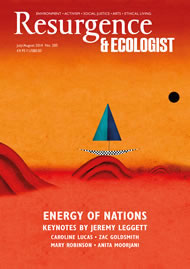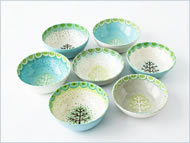How can today’s maker of ceramic tableware – objects so commonplace and yet so vital in our daily lives that they seem visible and invisible – lay claim to the sideboard or kitchen table? How can the ceramicist make pots that matter? Or at least give us a moment’s pleasurable pause, and stir some memory as we take our tea?
Katrin Moye has thought a good deal about this in her studio in a quiet Nottingham suburb. The first sight of her domestic work – white earthenware platters, jugs, plates, mugs, teapots and the like – sends out a message of expressive cheer. The spots are jaunty; the stripes are bold; the representation of Nature and birds has a playful, stencilled crispness. The palette of glaze colours is affirmative, too: sharp and soft in turns, pastel greens, yellows and blues.
These are pots with a carefree delicacy of touch, made for the ritual of food and drink, and beyond this, to add a momentary grace to these ordinary events. In this way, Katrin’s work is a dedication to family gathering, to the memory of times past – the wares have a 1950s’ feel about them. They have been made with a reflectiveness of mind, but also a busyness of hand, since her images “more often cover the surface than not”.
These are pots made to sit well for a family supper, or even an afternoon tea where that now little-seen formal cake stand might take pride of place, redolent of a Lyons tea room and a contemporary interest in artisanal baking. They are plates that have been carefully controlled, with exacting decoration and precise imagery: the skeletal trees that parade in order on the plate or jug, the regulatory regime of a topiary platter. There are dishes and jugs evoking the seasons, woodlands and the rhythms of organic life. Katrin talks about her “love of symmetry and the delicacy of branches in wintertime and the buds in spring like a secret unfolding”.
Her imagery has deeply rooted personal associations as well as its consideration of textile and ceramic practice. The patterns recall both the prints of Enid Marx and the drawings and the Wedgwood ceramic designs of Eric Ravilious, for example. But they draw, primarily, from a personal well. They bring to life Katrin’s memories of her readings, as a child, from Scandinavian and German folk stories. These are formalised into her structured patterns, but they are also the means of making a new reality for those remembered narratives and childhood. They are pots of deep affection and selflessness. They are pots that, as Katrin observes, “connect me to who I am”, with “memories as real as now”. They describe a folk place of imagination.
This connection to self and its transformation into a rural idyll is also made explicit by the titles of some of her patterns. ‘Christa’, named after her aunt; red dots for ‘Elsa’; a shirt pattern for her father, called ‘Johnny’. These are ceramic works intended for many other homes that also symbolise her own family memories.
Katrin’s career as a successful potter has been recharged through a period of time in 2013 (with the aid of funding from Arts Council England) of creative mentoring and reflection. Running a small but demanding studio to keep pace with the insistent demands of supply and demand, quality control and the overseeing of staff, often mitigates against creative development and risk-taking. Katrin wanted to take time to consider her business model in more depth; to ask herself a serious question about creative direction and quality of life, and this period of time enabled her to refocus on decoration of the ware and move a step back from being a driven production potter. With the guidance from her ‘fine mentor’ Kate Stoddart, she stopped making trade tableware, and finds herself back in control, in a state where she feels “my creativity has blossomed”. Her imagery is now, so to speak, liberated.
But this is not just a moment of equanimity. She still feels something of “a sense of flux and hesitancy” and still seeks to develop her whole range of work, looking to take a further step “from just beautiful surface decoration in order to invest more meaning and significance into my work”. Her ceramics will continue to connect to other forms such as her paintings and prints of still lifes of the tableware. Her reading is also important to this decorative development. She discusses the impact of Edward Thomas’ poetry, and one can also sense the acuity for countryside in The South Country, which Robert Macfarlane memorably described as “a dream map” – perhaps a phrase for Katrin’s work, too.
These are ceramics of a sophisticated naivety: popular but not populist. The challenge she has set herself is “to feel proud of what I am doing without just repeating what I have done”.
For more information on Katrin Moye: www.katrinmoye.com







